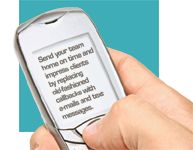Technology for client communication
Send your team home on time and impress clients by replacing old-fashioned callbacks with e-mails and text messages.
IT'S 7 P.M AT THE CLINIC, AND SALLY and Emily are staring at a stack of records requiring dozens of phone calls and a list of appointment reminders they need to fill out before going home. It's like this every night. Sally looks at Emily, rolls her eyes, and hands her colleague half the records.

Ernest E. Ward Jr., DVM
"Let's just get this done," Sally says. "I haven't read to my daughter all week."
"I know the feeling," Emily says. "I don't know how much longer I can do this. My husband is encouraging me to find another job where I can get home at a decent hour." Just then Dr. Nolife approaches the two staff members.

"Great. I see you two are getting started on those callbacks," she chirps. "If you need anything, I'll be over here writing up today's records. You two are so awesome." The doctor exits with a satisfied smile and a heaping armful of patient records.
"I couldn't live like that," Sally says. "She never gets home before 9 o'clock, but she doesn't seem to mind."
"I hate to say it, but we are living like that," answers Emily. "The only difference is that we can't stand being here late. We have lives outside of this place."
So ends another day at a busy veterinary hospital in America. Employees think about quitting, the boss remains oblivious, and clients and patients pay the price in poor service and care from the overworked, stressed-out team.
Keeping employees late is a major contributor to poor staff morale and high turnover, and it's the hospital owners who are responsible. But there's hope. If your clinic is overwhelmed by after-hours phone duties, it's time to implement some creative ideas. Below and on the following pages are some ways my clinic team redefined our approach to clinic-to-client communications using the newest technology. I bet some of them will work for you too.
1. E-MAIL FOLLOW-UP
- What it is: E-mail was our first foray into virtual client communication because it was low-cost, easy to implement, and widely used by our clients. Our database of e-mail contacts and the success of our e-mail newsletters showed us that our clients would accept this new form of communication.
- How it works: Our first step was to use e-mail to discuss pets' recent visits. We used existing callback rules to determine what types of contact would be appropriate. For example, a callback on flea allergy dermatitis was deemed appropriate for e-mail, while acute pancreatitis was not.
Next, we verified our clients' current e-mail addresses and asked them for their communication preferences when they were filling out registration forms or online making an appointment. The vast majority said they preferred to be contacted by e-mail except for emergencies. Even senior citizens proved to be more Internet-savvy than we'd anticipated.

After we got these preferences, we entered reminders into our practice management software and linked them to diagnoses that would generate e-mails in a specified time period. For example, if a patient was diagnosed with flea allergy dermatitis, we had the system send an e-mail 48 hours later. This first e-mail asked how the pet was feeling and if the client had any questions. We attached information about the condition below the message.
- Why you should use it: Results were impressive. We received responses from more than 80 percent of our "care-mails" during the first month. When we received a response, we cut-and-pasted the text directly into the patient's electronic medical record. Fast, easy, and permanent. We also reduced the number of callbacks dramatically. Instead of 15 to 30 calls a day, we made 10 or fewer. Staff morale soared and the attitude toward making calls improved. What had once been a dreaded duty became what it was intended to be: a compassionate inquiry about a serious condition.
2. E-MAILING APPOINTMENT REMINDERS
- What it is: With care-mails so well received, our next step was better appointment reminders. An automated telephone reminder system was out of my price range. So we began to dabble in e-mail appointment reminders. Because we couldn't directly link our appointment scheduler to e-mail reminders, we had to be more clever than the software programmers. So we created an appointment-reminder invoice code for all transactions involving a follow-up visit.
- How it works: If we wanted to see an osteoarthritis patient for a recheck exam and blood tests in one month, the client would receive two e-mails reminding them of their upcoming appointment. Our software generates these messages automatically. They read, "It's time for [PET'S NAME]'s 14-day recheck appointment on XX/YY/200Z. Please call and verify your appointment time or reschedule." We also started using e-mail reminders for the next year's annual examination, follow-up blood tests, and so on. We continue to mail postcard reminders for these long-range appointments and view the e-mail system as an adjunct. It costs us nothing and helps train clients to look for virtual correspondence from us as opposed to snail mail. Granted, this system pales in comparison to those used by large human hospitals, but it's a start.
- Why you should use it: Before, our goal had been to call clients one or two days before a scheduled appointment. Our success rate was directly related to team members' available time and ambition. In other words, it was spotty at best. According to human-medicine studies, the average physician loses roughly $150,000 per year because of missed appointments. My veterinary practice had less than 10 percent no-shows, but missed appointments were still costing us tens of thousands of dollars every year. Now it's less.

3. CELL PHONE TEXT MESSAGING
- What it is: Our first step in using text messaging on cell phones was to communicate about the status of surgical and dental patients. We were often calling clients with preanesthesia test results midmorning, and we couldn't reach them because they were working, traveling, or otherwise inaccessible. We brainstormed solutions and realized that many of us in the hospital checked text messages during work. We concluded that it's socially acceptable today to quickly read a text message during other activities.
- How it works: We use a clinic cell phone and short message service (SMS) to send messages such as, "From Seaside Animal Care: Pre-op tests complete. All normal. Proceeding to surgery soon. Call 910-555-1234 w/ questions." Common messages are stored in our phone to speed up the time it takes us to send them out. Besides saving time, text messaging has led to better communication with clients. We have since experimented with SMS to provide daily updates on boarded pets (photos included for an additional fee), to contact hard-to-reach clients about test results or appointments, to remind pet owners to give heartworm preventives, and even to inform clients about the availability of earlier appointments.
- Why you should do it: The cell phone is the holy grail of clinic-to-client communication. The TV show American Idol brought text-messaging awareness to tens of millions, and the iPhone promises to transform the Internet experience for all owners of handheld devices. As clients use their cell phones for more and more things, veterinarians must be ready to leverage this technology to our advantage. At my clinic, when we asked clients if they'd like text messages on their pets' progress throughout the day, the majority of our busy clients immediately took us up on the offer. We assured them that we would text only if everything was going well, and that if there were any problems or questions, we would call.

4. E-MAILING TEST RESULTS AND OTHER INFORMATION
- What it is: In addition to reminders, we also e-mail test results, diagnostic plans, and additional information to clients. Many years ago we started "prescribing" Web sites by providing clients with a handout listing trusted Internet sites. Today we e-mail clients those links along with any other patient discharge information. We also use e-mail to communicate with clients during office hours when we need to share findings from digital radiographs, blood and urine test results, and photographs of lesions, and even to schedule discharge times. This is often more reliable and takes less time than using the phone to contact and update busy working clients.
- How it works: We use e-mail this way only in minor and straightforward cases. In more serious situations, a doctor or team member will call first, promising additional information to follow by e-mail. Sometimes I'll e-mail the results before I call and have the owner look at the radiograph or lesion photo with me on the phone as I outline my treatment or diagnostic plan. We also e-mail information to owners who drop off patients.
- Why you should use it: Using e-mail in conjunction with phone calls enriches clients' experience, keeps them well-informed, and allows them to better understand the need for a given test or treatment.

All these technology uses are largely uncharted territory in veterinary healthcare, and we're all pioneers. But it's clear that clients want to be in close communication with their veterinarian and other healthcare providers, and they're willing to embrace new technologies to preserve that connection. It's up to us to make these bits and bytes personal and warm and to use them to bring us closer to our clients, rather than relying on overworked and rushed team members to perform duties they abhor. A hurried, uncaring, disengaged, "I'm so ready to go home" phone call from your clinic may be causing more harm than good. Get creative, explore new technologies, and develop a strategy to serve your staff and clients. In the end, what matters most in client communication is showing our compassion, whether through a phone call, an e-mail, a text message—or something we haven't even heard of yet.
Dr. Ernest E. Ward Jr., a Veterinary Economics Editorial Advisory Board member, owns Seaside Animal Clinic in Calabash, N.C. Send questions or comments to ve@advanstar.com